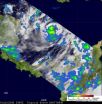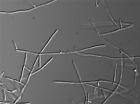Scientists release first cultivated ohelo berry for Hawaii
2010-09-25
(Press-News.org) The first cultivar of 'ōhelo berry, a popular native Hawaiian fruit, has been released by U.S. Department of Agriculture (USDA) scientists and their university and industry cooperators.
'Ōhelo (Vaccinium reticulatum Smith) is a small, native Hawaiian shrub in the cranberry family, commonly found at high elevations on the islands of Maui and Hawaii. As people scour the landscape to harvest this delectable berry for use in jam, jelly and pie filling, they unfortunately disrupt the fragile habitats where this plant grows.
In an effort to reduce damage to the environment and meet consumer demands, horticulturist Francis T.P. Zee, with the USDA Agricultural Research Service (ARS) Pacific Basin Agricultural Research Center (PBARC) in Hilo, Hawaii, is evaluating 'ōhelo for small farm production and ornamental use. Zee collaborated with fellow ARS scientists and cooperators at the University of Hawaii at Manoa, Big Island Candies and the Big Island Association of Nurserymen. ARS is the principal intramural scientific research agency of USDA.
Zee and his team selected the offspring of seed-grown plants to create the new cultivar "Kilauea" for berry production. They found 'ōhelo's tiny seeds readily germinated under 20-30 percent shade in well-watered and well-drained potting mixture. Plant hardiness and vigor improved with age, and some seedlings flowered just 10 months after germination, much sooner than the 5 years reported in previous studies. The 16-month-old plants Zee successfully transplanted from the greenhouse to the field produced berries a year later.
Zee also used cuttings and tissue culture to propagate selected 'ōhelo of high ornamental potential. With proper care, young, growing shoots of 'ōhelo can be groomed into vibrant, colorful ornamental potted plants. Since the plant is not seasonal, its readiness for market can be scheduled by trimming and fertilizing. Older potted 'ōhelo plants can be trained into a bonsai and can readily adapt to the office environment.
Zee and PBARC scientists are currently examining the disease and insect problems associated with growing potted 'ōhelo. Full descriptions of Zee's 'ōhelo studies can be found on the University of Hawaii's College of Tropical Agriculture and Human Resources' (CTAHR) website.
INFORMATION:
USDA is an equal opportunity provider, employer and lender. To file a complaint of discrimination, write: USDA, Director, Office of Civil Rights, 1400 Independence Ave., S.W., Washington, D.C. 20250-9410 or call (800) 795-3272 (voice), or (202) 720-6382 (TDD).
END
ELSE PRESS RELEASES FROM THIS DATE:
2010-09-25
CORVALLIS, Ore. – A new study has determined that teenagers who have abortions are no more likely to become depressed or have low self-esteem than their peers whose pregnancies do not end in abortion.
The study conducted by researchers from Oregon State University and University of California, San Francisco, is the first to use both depression and low self-esteem as outcomes with a nationally representative sample of adolescents.
The researchers found that young women in the study who had an abortion were no more likely to become depressed or have low self-esteem within ...
2010-09-25
You'd think that people choosing to live near to outdoor recreation amenities would have a lower body mass index or BMI thanks to an increase in all that healthy outdoor activity right on one's doorstep. Yet a new University of Alberta study looking at the relationship between reasons for choosing a neighbourhood to live in, physical activity and BMI, shows that's simply not the case.
In fact researchers found that those who said they'd moved to be closer to outdoor recreation opportunities actually showed a marked increase in BMI over the six years of a longitudinal ...
2010-09-25
BOSTON—In the quest to arrest the growth and spread of tumors, there have been many attempts to get cancer genes to ignore their internal instruction manual. In a new study, a team led by Dana-Farber Cancer Institute scientists has created the first molecule able to prevent cancer genes from "hearing" those instructions, stifling the cancer process at its root.
The study, published online by the journal Nature, demonstrates that proteins issuing stop and start commands to a cancer gene – known as epigenetic "reader" proteins – can be targeted for future cancer therapies. ...
2010-09-25
With several advanced warfare vehicles and a lineup of exciting technologies, the Office of Naval Research (ONR) will showcase its latest expeditionary equipment at the 2010 Modern Day Marine Exposition scheduled Sept. 28-30 at Quantico Marine Corps Base, Quantico, Va.
Modern Day Marine is one of the world's largest trade shows featuring expeditionary warfare equipment. More than 400 exhibitors and 8,000 attendees are expected to attend the event—now in its 30th year—for an up-close look at equipment and systems that support the U.S. Marine Corps and other allied forces' ...
2010-09-25
An instrument on NASA's Aqua satellite noticed increasing colder cloud top temperatures of tropical depression 15 in the south-central Caribbean just before it strengthened into Tropical Storm Matthew late on Sept. 23. The TRMM satellite also spotted heavy rainfall within the system. Matthew is now headed to the western Caribbean and watches and warnings are in place as Matthew may continue to strengthen.
Cloud top temperatures indicate the strength of the storm to forecasters. The colder the cloud top temperatures, the stronger the convection and uplift. When cloud top ...
2010-09-25
Towering thunderstorms and heavy rainfall are two things that NASA's CloudSat satellite saw as it passed over Typhoon Malakas, and those two factors confirm a strong storm. NASA's CloudSat satellite's Cloud Profiling Radar can basically slice a tropical cyclone in half and take a look at its clouds and rainfall, and that's what it did when it passed over Typhoon Malakas on Sept. 23.
CloudSat flew over Typhoon Malakas during the daytime on Sept. 23. At that time, Malakas had a minimum central pressure of 965 millibars, maximum winds of around 115 mph (100 knots), and ...
2010-09-25
The GOES-13 satellite has been keeping an eye on Tropical Storm Lisa and watched her birth, graduation to depression then tropical storm and back to depression. Now, Lisa has grown back to tropical storm status, but it may be short-lived.
At 11 a.m. EDT on Friday, Sept. 24, Tropical Storm Lisa had maximum sustained winds near 50 mph and she may strengthen and weaken over the weekend, but by Sunday colder waters will zap her energy source and she is forecast to be a depression.
Meanwhile, on Sept. 24, she was still frolicking in the eastern Atlantic, about 320 miles ...
2010-09-24
How could the current financial crisis have happened? While fingers have been pointing to greedy banks, subprime-loan officers, and sloppy credit card practices, these are not the only contributors to the economic downturn. A new report in Psychological Science in the Public Interest, a journal of the Association for Psychological Science, examines the psychology of financial decision making, including the role of risk in making economic choices, how individuals behave in stock and credit markets, and how financial crises impact people's well-being.
Risk taking is a ...
2010-09-24
SAN ANTONIO, Texas, U.S.A. (Sept. 22, 2010) – Candida albicans, a fungus that kills more than 10,000 people with weakened immune systems each year, grows more dangerous as it forms and extends long strands of cells called hyphal filaments. In a paper published this month, UT Health Science Center San Antonio microbiologists describe a key factor involved in this damaging growth.
This finding may eventually lead to targets for antifungal strategies, the scientists said.
Patricia Carlisle, a Ph.D. student at the Health Science Center, and David Kadosh, Ph.D., assistant ...
2010-09-24
AURORA, Colo (Sept. 22, 2010) Antisocial boys who abuse drugs, break laws, and act recklessly are not just "bad" kids. Many of these boys may have malfunctioning brains, according to a new study by researchers at the University of Colorado School of Medicine.
"Brain responses to everyday rewards and punishments gradually guide most youngsters' decisions to conform with society's rules. However, when these seriously troubled kids experience rewards and punishments, and make decisions, their brains apparently malfunction," said Thomas Crowley, MD, a professor of Psychiatry ...
LAST 30 PRESS RELEASES:
[Press-News.org] Scientists release first cultivated ohelo berry for Hawaii



